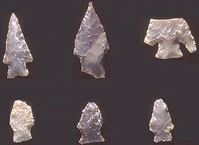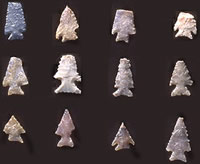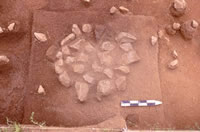Artist's depiction of an early hunter
using weaponry introduced during the Austin phase in
central Texas—the bow and arrow. Painting by Charles
Shaw.
Click images to enlarge
|

Archaic dart points from the Graham-Applegate
site. Photo by Milton Bell.
|

Scallorn arrow points from the Graham-Applegate
site. Photo by Milton Bell.
|
|
|
|
What happened to the Austin phase people is unknown.
|
|
Around A.D. 700, the aboriginal hunters of
central Texas began using the bow and arrow and eventually
discarded the older atlatl and dart that had been in use for
thousands of years. The arrival of this new weapon technology
is signaled in the archeological record by the appearance
of small, thin, stone points that tipped arrows, in contrast
to the larger, heavier ones used on darts or spears. Arrow
points mark the end of the Archaic era and the beginning of
what most archeologists call the Late Prehistoric period.
Early archeologists were aware of the late appearance
of the bow and arrow in Texas (and the rest of North America),
but it was not until excavations in Texas rockshelters between
the mid-1950s through the early 1960s, that two distinct bow-and-arrow-using
culture groups were identified.
The earlier of the two cultures is called the
Austin phase. The earliest arrow points had notches
flaked into the corners of the bases to facilitate hafting
to the arrow shaft. Archeologists have identified several
different styles of corner-notched arrow points in central
Texas but the most common and widespread are the Scallorn
type, the same type used at the Graham-Applegate rancheria.
Scallorn points are found over wide areas of Texas and adjacent
states. For this reason, some archeologists speak of an Austin
horizon, meaning a set of cultural traits, principally
the Scallorn point style, that extends over very large regions.
This style of arrow point was used by the agricultural Woodland
cultures of the midwest and early Pueblo cultures of the Southwest,
as well as hunter-gatherers of south and coastal Texas. But
in central Texas, the people who used Scallorn points had
a different culture that grew out of a long and successful
tradition of hunting and gathering among the hills and villages
of central Texas. The Austin peoples reoccupied campsites
of Late Archaic folk, built nearly identical house forms,
and, in some cases, re-used Archaic-period earth ovens.
There were differences from the Archaic, however,
besides just the use of the bow and arrow. Formal cemeteries
came into use for the first time in central Texas during this
late period (although earlier Archaic-period cemeteries have
been documented in sites south and east of the site). What
is most unusual about the Austin phase cemeteries is the finding
of Scallorn arrow points embedded in some of the skeletal
remains. This suggests that warfare—perhaps borne of
territorial disputes or population pressures—may have
may have been a concern for the peoples of this time period.
Based on what was found at sites such as Loeve-Fox
in Williamson County and Pat Parker in Travis County, burial
grounds were unusually compact, occupying an area of around
100 square feet. The bodies are invariably in a flexed position,
with the heads often oriented towards the north. Isolated
burials are also known, such as that found in the late 1930s
in San Saba County near the Colorado River and a later discovery
at Cottonwood Terrace, also near the Colorado River in Burnet
County. Both these burials were covered by large rocks, either
as grave markers or to protect the bodies from scavenging
animals. Although the sample is very small, it is interesting
that the known cemeteries occur on the prairies east of the
escarpment, while only isolated burials are known to the west
on the Edwards Plateau (including the Llano Uplift). It is
likely that Austin folk living on the Plateau continued a
long tradition of using natural sinkholes as burial places,
a practice that often leaves little or no permanent trace.
All the burials discussed above have been assigned
to the Austin Phase because they contain Scallorn arrow points
in or near the skeletons. One could make the argument that
some of the points were included in the burials as grave goods,
but in many cases, such as with some of the burials at Loeve-Fox,
the position of the points suggests that they were embedded
in the people buried there. Scallorn points were also apparently
what killed the individuals from the two isolated burials
mentioned above. The San Saba individual had two points in
the chest cavity, while the Cottonwood Terrace skeleton had
a point embedded in the neck area. It should also be pointed
out that there are Austin phase burials, such as the two from
Kyle Rockshelter in Hill County that do not contain arrow
points.
Much of what is known about Austin phase culture
comes from excavations of burial sites and rockshelters. Comparatively
few are open campsites, especially ones with only (or even
mostly) Austin phase occupation. The Graham-Applegate site
is helping to provide a more-complete account of human life
in central Texas in the last centuries of prehistory. For
example, it is now known that Austin phase people used earth
ovens that resulted in the formation of large burned rock
piles (or middens), a cooking technique that archeologists
once thought belonged exclusively to the earlier Archaic period.
It appears that the Austin phase came to an end sometime in
the fourteenth century, or at least the evidence of their
culture diminishes or changes.
Long after the Graham-Applegate rancheria was
abandoned, a late Austin phase group, perhaps a hunting party,
returned to the site and cooked a meal on a stone hearth.
They repaired their arrows and tossed away broken Scallorn
points. A radiocarbon date from the wood they burned fell
to between A.D. 1285 and 1405, a very late time for these
people. What finally happened to the Austin phase people is
unknown. While it is possible they were wiped out by warfare,
more likely they simply adopted the trappings of the succeeding
Toyah phase folk and no longer made tools that we can identify
with the Austin phase.
|
| |
|
Warfare, perhaps borne of territorial disputes,
may have been a concern for peoples of this time period.
|

Remains of a cooking hearth used
by late Austin phase peoples sometime between A.D. 1285
and 1405.
|
|